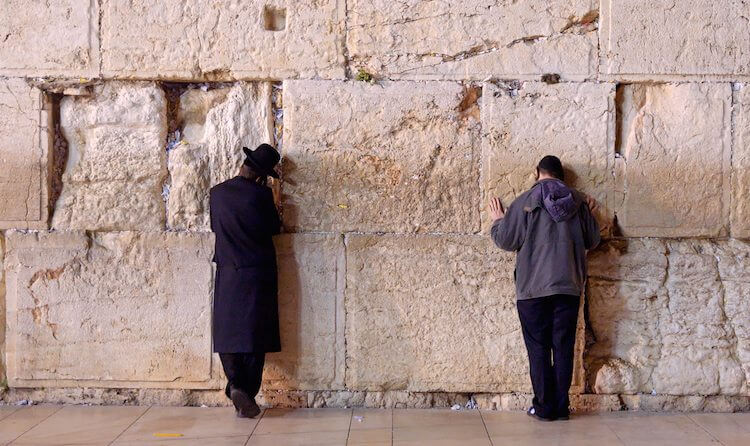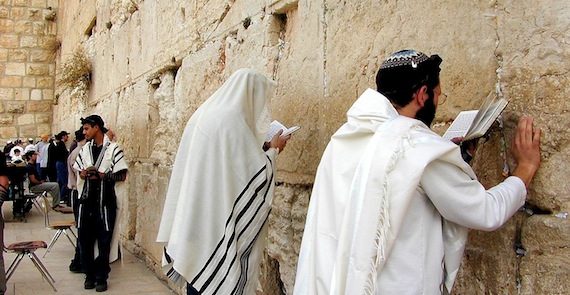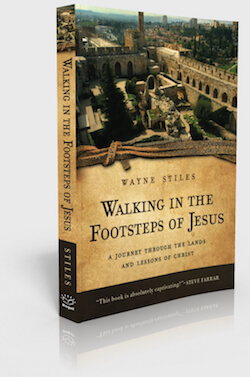Some people find it hard to identify with the Jews who rock before Jerusalem’s Western Wall. When I first saw them, the prayers seemed odd. Then I thought about my traditions. Are they any less bizarre?

(Photo: Men praying at the Western Wall. Courtesy of the Pictorial Library of Bible Lands)
Oddness just comes in different flavors. They’re called “traditions.” For example:
- Jews pray with their heads covered; we take our hats off.
- Their prayers are public and often loud; ours are private and quiet.
- They rock back and forth and pray from a book; we bow our heads, close our eyes, and utter unrehearsed words.
It’s easy in the familiarity of our own traditions to shake our fingers at the oddities of others. Jews pray while rocking, Muslims kneel with their bottoms in the air, and Christians bow our heads and close our eyes.
But blend any tradition—bowing, standing, prostrating, rocking, kneeling, or jumping—with no personal relationship with the true God, and it’s pointless.
How can we make sure we don’t confuse truth with tradition?
Confusing Truth with Traditions
Before meals, my grandfather used to pray the same short prayer in Spanish. And while I didn’t understand a word of it, I could soon repeat it verbatim. My bedtime prayers as a boy followed the same pattern:
Now I lay me down to sleep, I pray the Lord my soul to keep; if I should die before I wake . . .
I could rattle that puppy off in about 10 seconds. But my heart was not in it.
Even our “extemporaneous” prayers follow traditions, don’t they?
- Ever heard those who mutter “Father God” in every sentence they pray?
- What about bowing our heads and closing our eyes—where is that in the Bible?
- Even praying “in Jesus’ name” has become little more than a verbal cue for the end of a prayer. In fact, I dare you to end a public prayer without it and see if it doesn’t at least feel odd—almost like sacrilege. Someone may even question you on it.

(Photo: Men praying at Jerusalem’s Western Wall. Courtesy of the Pictorial Library of Bible Lands)
Praying with Your Eyes Open
Old habits die hard, don’t they? After giving thanks for dinner one evening, I opened my eyes to see one of my daughters just staring at me. “Do you know you pray the same thing every time?” she asked. From the mouths of babes. So the next night I made sure to pray from the heart. “You changed it!” she exclaimed.
If you are where you can, read Jesus’ familiar words out loud—all of them:
When you pray, you are not to be like the hypocrites; for they love to stand and pray in the synagogues and on the street corners so that they may be seen by men. Truly I say to you, they have their reward in full. But you, when you pray, go into your inner room, close your door and pray to your Father who is in secret, and your Father who sees what is done in secret will reward you. And when you are praying, do not use meaningless repetition as the Gentiles do, for they suppose that they will be heard for their many words. —Matthew 6:5–7
Two actions to notice about Jesus’ words:
- Praying to be seen by others rather than by God alone.
- Praying with meaningless repetition rather than from the heart.
Let’s make sure not to confuse the truth with our traditions. And in exercising our traditions, let’s keep our hearts engaged.
Tell me what you think: What other traditions do we do that aren’t in the Bible? To leave a comment, just click here.

Like This Post? Get the Whole Book!
This post is adapted from Wayne’s book, Walking in the Footsteps of Jesus: A Journey Through the Lands and Lessons of Christ.
• Enjoy an engaging, inspiring, and humorous travelogue that mingles the life-changing truths of Jesus with a walking tour of the Holy Land.
• Experience the Holy Land through the sights, sounds, and tastes of this personal travelogue, and discover how these sacred places influenced the lessons Jesus taught.
You will discover lessons Jesus has for your life.
